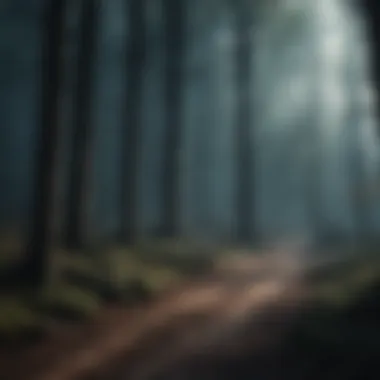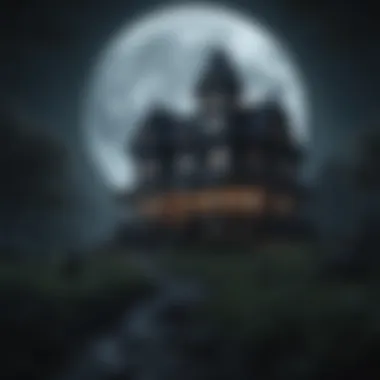The Most Anticipated Scary Movies of This Year


Intro
In recent years, horror films have evolved, branching out into diverse thematic territory not seen before. This year marks an exciting juncture for the genre, with several anticipated releases set to make an impact. As audiences grow more discerning and demand innovative narratives, filmmakers are challenged to push boundaries. This article delves into the upcoming horror films of the year, outlining their premises, notable cast, and where they stand in the shifting landscape of horror cinema.
Anticipated Releases
As we explore the horror films premiering this year, it is essential to highlight some key titles. Each film presents unique stories that reflect societal fears and shifting audience preferences. Here are a few key releases to look out for:
- A Haunting in Venice - This film, based on Agatha Christie’s novel, promises to blend mystery and horror, featuring an impressive cast.
- The Nun II - The sequel to the popular franchise delves deeper into the lore of the demonic nun. Fans are excited to see how this installment evolves.
- Talk to Me - This upcoming thriller explores themes of grief and communication with the dead, inviting a fresh perspective on familiar horror tropes.
Shifts in Themes
The horror genre is undergoing significant changes. Filmmakers are no longer constrained by traditional horror elements. Instead, they are infusing psychological depth, cultural narratives, and social critiques into their stories.
- Psychological Horror - Movies now often explore the human psyche, presenting characters that resonate on a personal level.
- Cultural Narratives - Film producers are drawing from diverse cultural backgrounds, creating relatable stories for various audiences.
"The evolution of horror reflects our society's changing fears. What once scared us may not evoke the same feeling today. "
Audience Preferences
As we analyze viewer trends, it is apparent that audience expectations have shifted significantly. Today’s viewers seek more than just jump scares. They crave complexity, depth, and a connection to the narrative.
- Diversity in Representation - Viewers increasingly demand inclusive storytelling that resonates across a broader spectrum.
- Character-Driven Plots - Characters with tangible backstories and motivations tend to draw in audiences, creating a bond that enhances the viewing experience.
Prolusion to Horror Cinema in the Current Year
The realm of horror cinema has always held a significant place in the film industry. It caters to deep, often unspoken fears and challenges societal norms. As we look into this year, the importance of horror movies becomes more apparent. Horror reflects current anxieties and allows audiences to process fears in a controlled environment. It is also a crucial avenue for filmmakers to showcase innovative storytelling techniques, helping to evolve the genre continually.
Defining Modern Horror
Modern horror is not easily defined. It encompasses a wide array of narratives, styles, and themes. Traditional horror once relied heavily on jump scares and predictable plots. Today, it often delves into psychological elements and societal critiques. Many contemporary films challenge the viewers’ understanding of fear and morality. They push boundaries by portraying realistic scenarios that tap into true fears, such as isolation, technology, and existential dread. This shift indicates a more sophisticated audience seeking depth in their viewing experience.
The Evolution of Horror Themes
Over the decades, the themes in horror films have evolved significantly. Early horror focused primarily on supernatural elements. Classic films often featured monsters, ghosts, and otherworldly entities as central figures. However, as society's understanding of horror has grown, so have its themes.
In recent years, horror has embraced aspects of realism. Films now explore themes such as mental illness, trauma, and social justice. Many upcoming films this year seem poised to reflect ongoing cultural shifts, addressing issues pertinent to today's viewers. Such themes not only increase engagement but also encourage critical thought about underlying societal issues.
"Horror film is a reflection of contemporary fears; it evolves as society changes."
By examining the current landscape of horror cinema, we can gain valuable insight into the types of stories that resonate with audiences today. The genre's adaptability ensures its relevance and continued evolution.
Key Trends in Upcoming Scary Movies
The landscape of horror films is continuously evolving, influenced by cultural shifts, technological advancements, and audience preferences. Understanding the key trends in upcoming scary movies is crucial not just for industry insiders but also for viewers eager to grasp what new experiences await them. This section elaborates on various aspects of these trends, offering insights into rising subgenres, innovations in filmmaking, and the societal influences that shape horror narratives.
Rising Subgenres of Horror
In recent years, the horror genre has seen the emergence of several rising subgenres. While traditional horror remains popular, new categories like psychological thriller, folk horror, and even horror-comedy are gaining ground. Each subgenre often reflects the anxieties and experiences of its time. For instance, psychological thrillers lean into our deepest fears, exploring mental health themes and moral dilemmas that resonate well with modern audiences. Similarly, folk horror draws inspiration from ancient culture and traditions, often intertwining folklore and supernatural elements.
Many filmmakers are now experimenting with hybrid genres, blending horror with romance or science fiction. Movies that incorporate elements from various genres often attract a broader audience, making horror more accessible and relatable. For viewers, this variety enriches the cinematic experience, offering multiple lenses through which to engage with fear.
Technological Innovations in Filmmaking


Advancements in technology are significantly influencing the production of horror films. Filmmakers now have access to tools that allow for unprecedented levels of creativity and realism. For instance, virtual reality (VR) and augmented reality (AR) are being utilized to create immersive horror experiences. This technology can transport the audience into the story, provoking intense emotional reactions. Moreover, CGI (Computer Generated Imagery) enables the creation of lifelike monsters and chilling visuals that were once merely a fantasy.
Sound design has also seen remarkable improvements. High-fidelity audio and innovative soundscapes can heighten tension and amplify scares. Many upcoming films are using surround sound techniques to envelop viewers in sound, making the horror feel tangible. As technology continues to advance, the potential to push the boundaries of horror grows, promising to keep audiences on the edge of their seats.
Cultural Influences in Horror Narratives
Cultural elements play a vital role in shaping horror narratives. As societies face various challenges and changes, these experiences often manifest in horror films. For instance, current global issues like climate change, political unrest, and technological dependence are becoming central themes in many upcoming horror movies. The cultural influences are not just there for thematic relevance; they also serve as a means for audiences to address and process current fears in a safe environment.
Moreover, representation within the genre is becoming increasingly important. Discovering stories told by diverse filmmakers, including women and artists from varied backgrounds, enriches the genre and allows for a broader exploration of fear experiences. This evolving landscape indicates that horror is not merely a genre to frighten but also a powerful platform for exploring and critiquing societal norms.
"The horror genre has the potential to reflect and challenge our realities while providing a unique form of social commentary."
In summary, understanding these key trends provides valuable insights into what audiences can expect in the upcoming horror films this year. With rising subgenres, technological innovations, and cultural influences, the future of horror appears to be not only frightening but also deeply engaging and meaningful.
Upcoming Horror Releases to Watch
Upcoming horror releases play a vital role in maintaining the genre's vitality and appeal. This year, the anticipation surrounding several films signals a shift in audience preferences and trends in horror cinema. By examining these upcoming releases, the article intends to provide insights into their thematic richness and potential impact in the industry.
Although horror films often evoke fear, they also reflect a variety of societal issues. Each film in this section encapsulates unique perspectives that reveal deeper narratives, ensuring a connection with the audience. This year's films resonate with themes of isolation, confronting unresolved trauma, and questioning reality itself. Such motifs add depth to the scares, enriching the viewing experience and often leading to compelling discussions after the film ends.
Film Title: Chilling Shadows
Premise Overview
Chilling Shadows introduces a chilling tale of darkness that reveals the inner fears of its characters. This premise stands out due to its clever engagement with psychological horror. Instead of relying solely on jump scares, it delves into the characters’ minds, making the audience confront their fears. This thoughtful approach enhances audience engagement, prompting deeper reflection on personal anxieties and how they manifest in relationships.
The unique feature of this film is its setting, where familiar places transform into sources of dread. By familiarizing the audience with these environments first, the horror becomes all the more palpable. This tactic draws viewers in, only to reverse their expectations later, contributing positively to its narrative depth and emotional resonance.
Cast and Crew
The cast and crew of Chilling Shadows reflect a blend of seasoned actors and emerging talent, which is significant for the film's success. This choice creates a balance of experience and fresh perspectives, enriching character portrayals. Notably, the director has a knack for evoking authentic performances from actors, directly contributing to the emotional weight of the story.
With a crew known for innovative camera techniques, the visual storytelling is also a highlight. Employing practical effects over heavy CGI gives a tangible quality to the horror, enhancing believability. However, this approach can introduce limitations in creative flexibility, but the outcomes often result in more immersive experiences.
Critical Expectations
Critics are eager to see how Chilling Shadows confronts traditional horror tropes. It aims to challenge conventions by inserting a reflective narrative. This focus on depth over shock is seen as a refreshing choice, appealing to discerning viewers.
Moreover, its trailers have sparked interesting discussions about the potential for social commentary within the horror framework. However, there is a risk that critics may be more demanding of films straying from standard formulas, which could impact initial reception. Overall, the expectations lean towards optimism, anticipating a contribution that elevates the genre.
Film Title: The Last Retreat
Plot Summary
The Last Retreat spins a gripping tale of survival in a remote landscape, emphasizing tension and psychological struggles. The backstory of the characters is intricately woven into the plot, providing a backdrop that enhances the unfolding horror. Such depth is beneficial as it invests the audience in the characters, making their fears more relatable and engaging.
This film has a structure that rotates between present horrors and flashbacks, which creates a compelling narrative drive. The approach may initially confuse some viewers but is ultimately effective in building suspense and enhancing understanding of the characters’ motivations.
Director's Vision
The director has outlined a clear vision for The Last Retreat, focusing on a raw depiction of fear and survival instincts. This element is crucial, emphasizing the human psyche under stress, which elevates the material beyond typical horror narratives. The artistic decisions made here bring a unique flavor to the film, enhancing both its visual and emotional palette.
However, this ambitious vision must strike a balance between horror and drama. If it leans too heavily into character development, it risks losing the core thrill expected from a horror film. Conversely, if it focuses only on scares, it may appear shallow and forgettable.


Audience Anticipation
The buzz surrounding The Last Retreat highlights a strong sense of anticipation among potential viewers. Many are curious about the survival theme in combination with horror, reflecting broader cultural concerns about isolation in contemporary society. These underlying messages resonate well with audiences seeking depth in horror experiences.
Expectations are particularly high as the marketing strategy has positioned the film as both thrilling and thought-provoking. Still, while audience anticipation is strong, it often leads to elevated expectations, which could pose challenges upon release if the film falls short.
Film Title: Silence Screams
Conceptual Framework
Silence Screams promises a disturbing exploration of the boundaries between the known and unknown. The unique conceptual framework offers a metaphor for isolation. This thematic focus serves as both a strength and a risk; audiences may deeply connect with the metaphors but risk losing some in abstract presentations.
The film intertwines experiences of different characters, depicting how silence can be its own form of horror. This aspect raises intriguing questions about communication and its absence, granting the film a certain philosophical depth. As audience members reflect on their own lives, this connection enhances the emotional pull but may alienate viewers who prefer clear narratives.
Character Dynamics
The dynamics between characters in Silence Screams are designed to create intense emotional conflicts, which is critical to the film's overall impact. This aspect elevates tension as viewers witness how fear can breed distrust and ultimately lead to destruction.
A notable feature is how these relationships develop under pressure, pointing to themes of loyalty and betrayal. Such dynamics are a powerful choice in horror, adding complexity to the storyline. However, maintaining character relatability amidst overwhelming fear presents challenges for the filmmakers.
Marketing Strategies
The marketing strategies for Silence Screams have focused on social media teasers that evoke curiosity. These promotions aim to build mystery, which can engage the audience effectively. By using questions and ambiguous imagery, the marketing invokes interest, pushing potential audiences to seek out more information.
However, there is a fine line between intrigue and confusion. If the marketing does not align with the actual content of the film, it may lead to disappointment. On the other hand, successful marketing can increase viewer turnout and interest, enhancing the potential for cultural discussion.
Film Title: Whispers in the Dark
Narrative Structure
In Whispers in the Dark, the narrative structure is characterized by an interwoven story that explores multiple timelines. This design showcases how past actions lead to present consequences. The intertwined tales create a complex experience, allowing audiences to piece together the narrative gradually.
This approach encourages engagement as viewers try to connect the dots, fostering a sense of rewarding discovery. Yet, it can present risks such as pacing issues and potential viewer frustration. Balancing these elements is crucial for the film's reception.
Production Insights
Behind the scenes, Whispers in the Dark has involved collaborative efforts among renowned professionals in different disciplines. This diversity in the production team enhances creativity. Furthermore, the use of practical effects is emphasized, aiming to return to horror roots that resonate well with long-time fans.
However, navigating budget constraints while ensuring high-quality production can be challenging. Still, dedicated efforts in production could lead to rewarding outcomes in terms of audience satisfaction.
Projected Box Office Performance
Projected box office performance for Whispers in the Dark appears strong, supported by an effective marketing campaign and established relationships with the audience. Factors such as star power and previous successful projects further bolster its expectations.
Nonetheless, box office predictions can be tricky as they depend on viewer sentiment closer to release. If audience response to promotions is unfavorable, it may impact turnout. Overall, current trends suggest a positive reception, particularly among fans who appreciate contemporary horror themes.
The Role of Streaming Services in Horror Film Releases
The landscape of horror cinema is shifting with the rise of streaming services. Platforms like Netflix, Hulu, and Amazon Prime Video are not merely distribution channels; they are reshaping how audiences access and engage with horror films. This transformation has implications for both filmmakers and audiences, affecting the types of stories told and the ways in which these stories resonate with viewers.
One of the defining features of this era is accessibility. Horror films, once primarily enjoyed in theaters, can now be experienced in the comfort of one's home. This accessibility is crucial for genre exploration. Horror fans can easily discover niche films that might not receive a wide theatrical release, contributing to a more diverse filmic landscape.
Impact of Streaming on Audience Accessibility


Streaming services have democratized access to horror films. With a few clicks, viewers gain instant access to a library of films that span various subgenres and styles. This has broadened the audience base significantly. No longer confined to traditional box offices, horror films can reach global audiences. Even indie filmmakers can distribute their works through these platforms without the barriers of traditional film distribution.
In addition, streaming services often feature algorithms that suggest films based on viewers' previous choices. This personalization increases the likelihood that an audience will encounter lesser-known horror films, fostering an environment of exploration. Such exposure is particularly beneficial for emerging filmmakers who rely on word-of-mouth and shares within the streaming community to gain recognition.
Exclusive Releases vs. Theatrical Releases
The debate between exclusive streaming releases and traditional theatrical releases continues to evolve. Many horror films, such as Paranormal Activity, thrived in theaters, leveraging large audiences and collective viewing experiences to amplify fear. However, streaming platforms have pioneered unique marketing strategies that cater to individual viewing preferences.
Exclusive releases allow for focused marketing campaigns while bypassing the intricacies of theatrical distribution. For instance, films like The Platform and Cam debuted exclusively on Netflix, capturing audience attention without the need for traditional promotional avenues. This strategy can cultivate a dedicated fanbase faster, offering a more tailored experience.
However, this model is not without its challenges. There is a debate about whether home viewing diminishes the intensity of horror films. The communal experience of watching a terrifying film in a packed theater can amplify the emotional impact. Streaming releases often lack that shared atmosphere of suspense. Yet, some argue that the opportunity to rewatch or pause a film provides a different kind of engagement that should not be underestimated.
Streaming services are redefining how we interact with horror cinema, offering accessible platforms for discovery while challenging traditional release models.
Comparative Analysis of Anticipated Scary Movies
In evaluating upcoming horror films, a comparative analysis serves as a crucial tool to understand the landscape of the genre. It allows audiences and critics to draw parallels between different projects, highlighting unique approaches and thematic shifts. This analysis can illuminate the diversity within horror cinema, showcasing how filmmakers are responding to modern societal fears and the ever-evolving artistic expressions in storytelling.
By comparing box office projections and expected critical reception, we can better grasp the factors influencing the commercial viability of these films. The anticipation surrounding a movie’s release not only hinges on its premise but also on its marketing and the reputation of those involved in production. Amidst varying expectations, this analysis helps delineate where each film fits and how it may resonate or falter in the market.
Box Office Projections
In the competitive world of film, box office projections are essential for assessing the anticipated financial performance of horror movies. These projections factor in various elements such as prior successes of similar films, the influence of star cast, and the timing of the release.
For instance, films that incorporate a unique twist or a standout narrative often generate higher expectations.
- Genre popularity: The horror genre has consistently attracted audiences, especially during specific seasons like Halloween.
- Pre-release buzz: Social media campaigns and trailers can dramatically influence audience interest, leading to increased box office success.
- Historical data: Analyzing past performances of comparable films provides valuable insights.
By examining these factors, stakeholders gain a clearer picture of potential financial outcomes and can strategize their marketing efforts accordingly.
Critical Reception Expectations
Another vital aspect in the comparative analysis is the expectation of critical reception. Critics play a significant role in shaping public perception and can heavily influence audience turnout. A well-received film typically enjoys stronger box office performance.
Key elements indicating how a film may be received include:
- Director and cast resume: Films helmed by established directors or featuring well-known actors have higher anticipation levels.
- Festival screenings: Premiering at notable film festivals can generate buzz and establish early credibility.
- Social commentary: Movies that engage with timely themes often attract both critical acclaim and audience interest.
Though projections and expectations can shift, understanding them provides a framework for anticipating future critical dialogue. This is part of what makes horror films fascinating as they interact with cultural fears and societal narratives, engaging viewers on multiple levels.
"A successful horror film not only entertains but also leaves a mark on social conversations."
Overall, a detailed comparative analysis of anticipated scary movies allows for a more informed understanding of the genre's landscape. It highlights what might set certain films apart from others in terms of commercial success and critical reception.
Closure and Implications for the Horror Genre
The horror genre has consistently evolved, reflecting societal fears and cultural narratives. In this article, we examined anticipated horror films and their potential impact. Understanding these implications is crucial, given that horror serves not just to entertain but to provoke thought and spark dialogue.
Anticipating Future Trends
Looking ahead, several trends emerge from the current landscape of horror cinema. One significant trend is the increasing incorporation of psychological elements. Films are focusing more on inner fears rather than just external threats. This shift encourages audiences to confront personal anxieties, which resonates deeply in today's world. Furthermore, as society grapples with complex issues like climate change and technological invasiveness, these themes are likely to become more prominent in horror narratives.
Another trend revolves around inclusive storytelling. More diverse voices in film production are informing fresh perspectives on horror. Experiencing horror through different cultural lenses can broaden the appeal of the genre, providing a richer tapestry of stories. Independent films are gaining traction, offering unique takes and allowing for more experimentation in style and narrative.
The Continuing Appeal of Horror Films
Horror films hold a lasting allure for various reasons. Their ability to elicit strong emotional responses captivates audiences. Fear, when experienced in a safe environment, can lead to an exhilarating sense of thrill. This reaction is intensified through communal viewing experiences, where shared scares create a bond among viewers. Additionally, horror often delves into the taboo, providing a safe space to explore fears that society usually shuns.
Moreover, the genre's adaptability ensures its relevance. Each new film reflects current societal concerns, adapting tochanging audience preferences. So, as long as there are fears to explore, horror will continue to thrive.
"Horror has always been a way to safely explore our deepest fears and societal anxieties, making its contribution to cinema profound."



